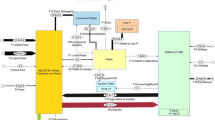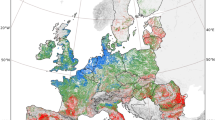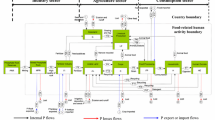Abstract
Phosphorus (P) is an essential nutrient required for plant growth and at the same time a costly pollutant, which can cause eutrophication of water bodies. Modern agriculture relies heavily on mineral fertilisers, which contain phosphorus derived from phosphate rock, because, without regular applications, crop yields would be limited. Since phosphate rock is a non-renewable resource, there are growing concerns regarding future phosphorus scarcity and the sustainability of modern agriculture. For many farmers, animal manure was once a means of maintaining soil fertility, but now it presents a major operational problem. This study evaluated the possibility of recycling phosphorus on a national and regional scale in Italy, using major sources of manure and wastewater. These results were successively compared with an estimate of the agricultural demand for phosphorus. Considering the quantity of phosphorus fertilizer that was applied to the soil–plant system, for the years 2001–2010, the annual phosphorus requirement of Italian crops was about 101,000 t of P. Therefore, the phosphorus source comprising animal manure and civil/industrial waste (117,500 t of P and 40,000 t of P, respectively) could potentially satisfy the average annual agronomic phosphorus demand. Regarding the geographical distribution of phosphorus supply and demand on a regional scale, areas with a large deficit of phosphorus included Calabria, Puglia and Marche. However, when only livestock waste was considered, Sicily, Umbria and Friuli could also be considered to be regions experiencing a phosphorus deficit.








Similar content being viewed by others
References
Bateman, A., Van der Horst, D., Boardman, D., Kansal, A., & Carliell-Marquet, C. (2011). Closing the phosphorus loop in England: The spatio-temporal balance of phosphorus capture from manure versus crop demand for fertilizer. Resources, Conservation and Recycling, 55, 1146–1153.
Bolzonella, D., Fatone, F., Gottardo, M., & Frison, N. (2018). Nutrients recovery from anaerobic digestate of agro-waste: Techno-economic assessment of full scale applications. Journal of Environmental Management, 216, 111–119.
Bonazzi, G. (2001). Liquami Zootecnici. Manuale per l’utilizzazione agronomica. Verona: Edizioni l’informatore agrario.
Bonomo, L. (2008). Trattamenti delle acque reflue. Milano: McGraw-Hill Education.
Carpenter, S., & Bennett, E. (2011). Reconsideration of the planetary boundary for phosphorus. Environmental Research Letters, 6(1), 12.
Cecchi, F., Battistoni, P., Pavan, P., Bolzonella, D., & Innocenti, L. (2005). Digestione anaerobica della frazione organica dei rifiuti solidi. Aspetti fondamentali, progettuali, gestionali, di impatto ambientale ed integrazione con la depurazione delle acque reflue. APAT–Manuali e linee guida, 13.
Cooper, J., & Carliell-Marquet, C. (2013). A substance flow analysis of phosphorus in the UK food production and consumption system. Resources, Conservation and Recycling, 74, 82–100.
Cooper, J., Lombardi, R., Boardman, D., & Carliell-Marquet, C. (2011). The future distribution and production of global phosphate rock reserves. Resources, Conservation and Recycling, 57, 78–86.
Cozzi, M., Viccaro, M., Di Napoli, F., Fagarazzi, C., Tirinnanzi, A., & Romano, S. (2015). A spatial analysis model to assess the feasibility of short rotation forestry fertigated with urban wastewater: Basilicata region case study. Agricultural Water Management, 159, 185–196.
Egle, L., Rechberger, H., Krampe, J., & Zessner, M. (2016). Phosphorus recovery from municipal wastewater: An integrated comparative technological, environmental and economic assessment of P recovery technologies. Science of the Total Environment, 571, 522–542.
European Commission. (2013). Communication from the Commission to the European Parliament, The Council, The European Economic and Social Committee and the Committee of the Regions. Consultative Communication on the Sustainable Use of Phosphorus (COM/2013/0517 final).
Gilbert, N. (2009). The disappearing nutrient. Nature, 461, 716–718.
Grundey, J. K. (1981). Anaerobic digestion of farm wastes-current stage of development in Uk agriculture. In Livestock waste: A renewable source; proceedings, 4th international symposium on livestock wastes-1980, April 15-17, 1980, Amarillo Civic Center, Amarillo, Texas. St. Joseph, Mich., American Society of Agricultural Engineers, c1981.
Hahn, R. H., Landeck, D. C., & Engineers, A. S. of A. (1999). ASAE standards 1999: Standards engineering practices data. American Society of Agricultural Engineers.
Heinzmann, B., & Engel, G. (2006). Induced ammonia phosphate precipitation to pre-vent incrustation and measures for phosphorus recovery. Water Practice & Technology, 1(3), 2006051. https://doi.org/10.2166/wpt.2006.051.
IFA. (2006). Production and International Trade Statistics. International Fertilizer Industry Association, Paris. Retrieved May 22, 2015 from https://www.fertilizer.org/En/Statistics/PIT_Excel_Files.aspx.
ISPRA. (2010). Studio sull’utilizzo di biomasse combustibili e biomasse rifiuto per la produzione di energia. ISPRA.
ISTAT (2011). 2010 Agricultural Census. Retrieved May 22, 2015 from http://dati-censimentoagricoltura.istat.it/Index.aspx.
ISTAT. (2014). Italian statistical yearbook, Fertilizers distributed in agriculture by type and region in 2012. Retrieved May 22, 2015 from https://www.istat.it/it/archivio/108926.
ISTAT. (2018). I.Stat: Water—Urban wastewater treatment, Population served by wastewater treatment plants in the provincial capitals by year. Retrieved February 14, 2018 from http://dati.istat.it/Index.aspx?DataSetCode=DCCV_DEPACQ&Lang=en.
Kumar, R., & Pal, P. (2015). Assessing the feasibility of N and P recovery by struvite precipitation from nutrient-rich wastewater: A review. Environmental Science and Pollution Research, 22(22), 17453–17464.
Miles, A., & Ellis, T. G. (2001). Struvite precipitation potential for nutrient removal from anaerobically treated wastes. Water Science and Technology, 43(11), 259–266.
Panasiuk, O. (2010). Phosphorus Removal and Recovery from Wastewater using Magnetite. Dissertation. Retrieved May 20, 2015 from http://urn.kb.se/resolve?urn=urn:nbn:se:kth:diva-58595.
Passino, R. (1995). Manuale di conduzione degli impianti di depurazione delle acque. Bologna: Zanichelli.
Prud’Homme, M. (2010). Peak phosphorus: An issue to be addressed (p. 1). Paris: Fertilizers & Agriculture, International Fertilizer Industry Association (IFA).
Regional Integrated Production Regulations. (2013). Disciplinari di produzione integrata (DPI): Veneto, Valle d’Aosta, Toscana, Sicilia, Sardegna, Provincia Autonoma di Trento e Bolzano, Piemonte, Marche, Lombardia, Friuli Venezia Giulia, Emilia Romagna, Linee guida Nazionali di produzione integrata, Umbria, Puglia, Molise, Liguria, Lazio, Campania, Calabria, Basilicata, Abruzzo.
Schröder, J. J., Cordell, D., Smit, A. L., & Rosemarin, A. (2010). Sustainable use of phosphorus: EU tender ENV. B1/ETU/2009/0025 (No. 357). Plant Research International.
Shu, L., Schneider, P., Jegatheesan, V., & Johnson, J. (2006). An economic evaluation of phosphorus recovery as struvite from digester supernatant. Bioresource Technology, 97, 2211–2216.
Torrent, J., Barberis, E., & Gil-Sotres, F. (2007). Agriculture as a source of phosphorus for eutrophication in southern Europe. Soil Use and Management, 23(s1), 25–35.
Viccaro, M., Cozzi, M., Caniani, D., Masi, S., Mancini, I. M., Caivano, M., et al. (2017). Wastewater reuse: An economic perspective to identify suitable areas for poplar vegetation filter systems for energy production. Sustainability, 9(12), 2161.
Xu, K., Li, J., Zheng, M., Zhang, C., Xie, T., & Wang, C. (2015). The precipitation of magnesium potassium phosphate hexahydrate for P and K recovery from synthetic urine. Water Research, 80, 71–79.
Zessner, M., & Lindtner, S. (2005). Estimations of municipal point source pollution in the context of river basin management. Water Science and Technology, 52(9), 175–182.
Acknowledgements
This work forms part of two research projects supported by grant of the Basilicata Region: the research project entitled “Innovative techniques for monitoring and management of municipal solid waste landfills and remediation of contaminated sites—POLLUTECH” (Contract Cod. No. 2/AP/05/2013REG-CUP G43G13000410009), in which Donatella Caniani is the principal investigator and the project “Smart Basilicata” (Contract n. 6386—3, 20 July 2016). Smart Basilicata was approved by the Italian Ministry of Education, University and Research (Notice MIUR n. 84/Ric 2012, PON 2007–2013 of 2 March 2012) and was funded with the Cohesion Fund 2007–2013 of the Basilicata Regional authority.
Author information
Authors and Affiliations
Corresponding author
Rights and permissions
About this article
Cite this article
Caniani, D., Viccaro, M., Schiavone, C. et al. The Balance Between Capturing Phosphorus from Manure and Wastewater and the Demand for Crop Fertilizer in Italy. Nat Resour Res 28 (Suppl 1), 77–92 (2019). https://doi.org/10.1007/s11053-018-9426-z
Received:
Accepted:
Published:
Issue Date:
DOI: https://doi.org/10.1007/s11053-018-9426-z




